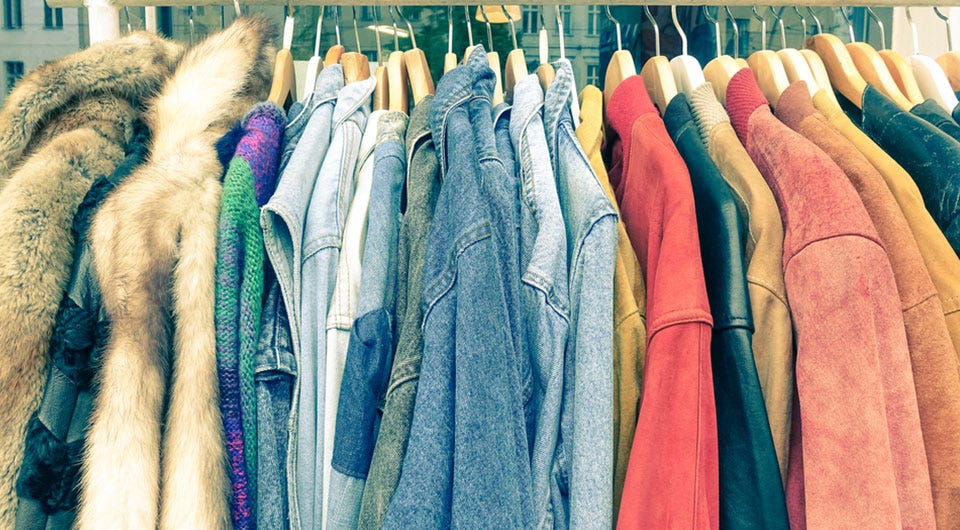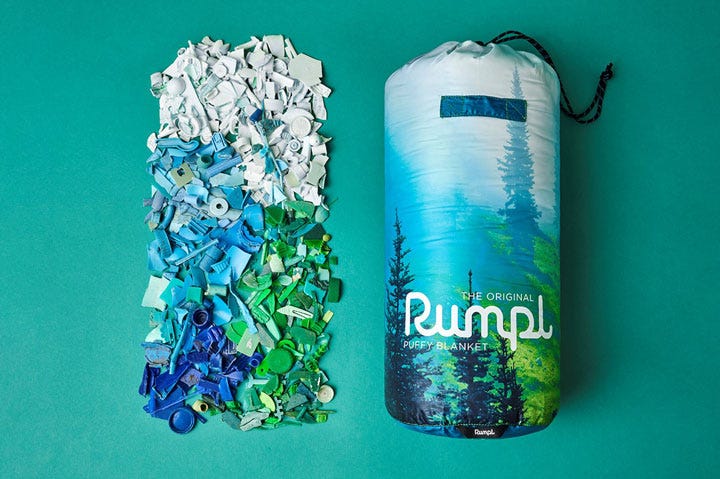🌱 The real impact of clothing resale platforms
We dive into the impact reports of the big players in resale
Happy Monday! Every Monday we suit up and get serious - digging into a climate topic, rounding up the past week’s Good(s) News and sharing updates from across FTF, so you’re never out of the loop.
While some of us have been distracted this weekend Following the Football (…see what I did there?), our dedicated team has been on the front foot, deep diving into second-hand fashion. We learn:
How resale platforms can help reduce fashion’s footprint
What impact platforms like Depop and Vinted are reporting
How fashion retailers can learn from leaders already offering resale to their customers.
Let’s dig in…
> Sponsor Spotlight
Zevero has worked with brands like MOTH, waterdrop, NICE Drinks and KERB. Today, they’re inviting Following The Footprints readers (that’s you) to a free 30-minute call to see how they can help you or answer any burning sustainability questions.
> In Focus
Sizing Up Second-Hand Fashion’s Impact
by Rosalin Brolly
It’s no secret that the Following the Footprint team are big fans of resale platforms. Just look at our recent team favourites in The Check-out where apps like Depop and Vinted make a regular appearance. And we’re not alone. thredUP’s Resale Report found that the global second-hand market is expected to double by 2027, growing 3x the speed of the apparel market as a whole. One of the key consumer motivators they attribute to this growth, especially in Gen Z, who are resale platforms’ biggest supporters, is sustainability. It’s almost taken as a given that buying clothes second-hand has a smaller impact on the environment than buying new clothes, but how is this impact quantified? Grab your (second-hand) bag, we’re going on a journey of impact discovery.
Resale as a circular business model
The Ellen MacArthur Foundation proposes resale as one of the circular business models to reduce the current linear fashion industry's 2.1 billion tonnes of CO2e impact. A key driver of this impact is increasing production of new clothing while clothing utilisation is simultaneously decreasing. The clothing resale market is attempting to flip these trends, increasing utilisation and decreasing new clothing production.
A Green Story LCA study for thredUP found that second-hand products across twelve categories had a lower environmental impact than new ones. The study measured global warming potential, blue water consumption, primary energy demand, acidification potential, eutrophication potential, freshwater aquatic ecotoxicity potential, human toxicity potential, marine ecotoxicity potential, and terrestrial ecotoxicity potential.

These savings were primarily due to the purchase of a second-hand product preventing consumers from buying the product new, and so avoiding the impact of producing the new product. To calculate the reduction in impact of reselling vs buying new a displacement rate is calculated, usually from customer surveys, as it’s not always a direct 1:1 displacement (due to impulse shopping or the resold product not being used).
Impact of resell platforms
Vinted’s 2023 impact report is hot off the press, produced in collaboration with carbon software company Vaayu. Through an LCA and displacement rate of 40% they calculated that in 2023 their platform avoided 678,691tCO₂e, or 1.25kg of CO₂e per second-hand purchase made on Vinted.
It’s worth pointing out that Vinted’s impact report went beyond carbon and also quantified their impact on user’s lives and consumption habits. They found that 36% of their consumers take care of their products so they can resell them and that UK and France buyers save an average €90 a month either from buying less or the reduced resale price. Both of these contribute to a reduction in new clothing production behind fashion's current monster of an impact.
However, it’s important not to ignore that there is an overconsumption problem with fashion that resale alone cannot solve. Second-hand fashion still has an impact as shown by Vinted’s 2023 operational footprint of 27,104 tCO₂e and Depop’s 2023 absolute emissions of 23,708 tCO₂e.
The major contributor of resale platform's emissions are delivery, contributing 98% of Vinted's overall emissions.
Resale and your brand
Great, you now understand the impact of resale platforms and how it is calculated, but what does this mean for your brand? You could join the likes of Dr Martens, Patagonia and Arc'teryx or 150 other brands that have launched resale programs. Bonus points if you match the ingenuity of the names behind these resale programs - Girlfriend to Girlfriend by Girlfriend Collective being my personal favourite.
Alternatively, why not capitalise on the existing resale platforms and set up a corporate account to sell your excess stock or products with minor defects like Lucy & Yak have done with their (im)perfect hubs hosted on Depop and eBay. This way you prevent these products ending up in landfill and displacing some of the environmental impact if this product was purchased new.
It’s also worth noting the impact of resale extends beyond environmental impact. Retailers enabling resale benefit from increased revenue and brand loyalty, with ⅔ of them seeing it as essential for long-term growth. In fact 42% of Gen Z is less likely to buy an apparel item if it does not have a good resale value.
The impact of reselling goes beyond a reduced environmental footprint, increasing revenue and brand loyalty. I think we were right to have Vinted and Depop on our team favourites.

Follow up with…
> Last week in consumer goods x climate…
The Good(s) News
Up and coming brands…
🎯 Notpla have partnered with Compass Group to supply seaweed-coated boxes to the Wimbledon Championships for packaging of the iconic strawberries and cream. For the Championships, Wimbledon have also added plant-based and zero-waste items to their carbon-rated menu.
🎯 OCEANR announced they are now B Corp certified, while BOL Foods has improved their B Corp score by 7 points following their recertification.
🎯 Rumpl released their 2023 impact report, highlighting milestones such as increasing their B Corp score, reducing their carbon footprint by optimizing their value chain, and using post-consumer recycled materials in their products. In 2023, they also donated over $250,000 to environmental organizations.
Bigger organisations…
⭐ Morrisons have partnered with Sea Forest to help reduce methane emissions from rearing cattle through the use of seaweed-based feed. If the initiative to incorporate SeaFeed into the cattle’s feed is approved, the meat products from this effort will be on shelves by 2026.
⭐ John West Foods has replaced the shrink wrap and cardboard on its tinned fish packaging with a recyclable aluminium strip. This change will save the brand 400 tonnes of steel annually. Additionally, the brand will also reduce excess ingredients like brine and oil by 1500 tonnes.
⭐ Gap, H&M, BESTSELLER, and Mango have partnered to launched the Future Supplier Initiative to share the expenses and responsibility of decarbonizing the fashion sector, and help brands meet their Science Based Targets. In partnership with The Fashion Pact, Apparel Impact Institute, Guidehouse, and DBS Bank, the initiative aims to to help suppliers transition to renewable energy and address the 99% of emissions coming from Scope 3.
⭐ Asahi UK, owner of Peroni and Grolsch, has partnered with LWC to make deliveries more sustainable by reducing up to 450 road journeys and saving 245 tonnes of CO2 annually through fewer but larger orders. Additionally, the project plans to plant over 3,700 trees, rewarding depots that meet vehicle reduction goals.
Industry wins…
⚡️The U.S. Plastics Pact has released Roadmap 2.0, a strategic plan to enhance plastic packaging reuse, recycling, and composting. The new plan builds on previous successes, including a reduction in problematic plastics and an increase in recyclable packaging, and sets ambitious goals to further reduce plastic waste and reliance on virgin plastics by 2030.

Want good news sooner? We post our top 5 stories every Friday on LinkedIn! If your CPG brand has good news to share, let us know.
> In case you missed it
Want more? Here’s what’s happening across FTF at the moment…
Last week we launched our new website! We’re really excited to have a way to share more resources than ever with you. Head over there to learn more about FTF, access MEASURE, meet the team and access the calendar.
We interviewed Brad Vanstone of Willicroft in our latest Meet the Brands interview. Catch up to read what they learned after carrying out an impact assessment of their products and what how their products are received around Europe.
That’s it for today!
Want more? Check out ‘The Check-Out’ this Thursday for the latest brands in our basket. In the meantime, if you want to get involved in our community activities, reply to this email or reach out at info@followingthefootprints.com to say hi.
Much love,
Team FTF


